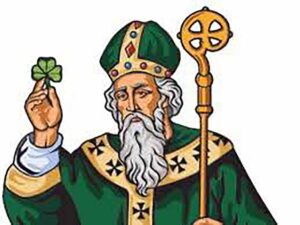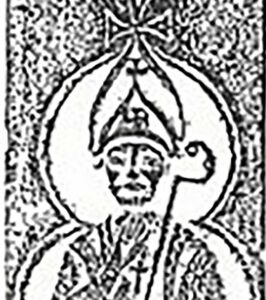
Age: It’s not polite to ask, but he died on this day AD461, according to what tradition you believe.
Famous for: Introducing Christianity to Ireland. George Bernard Shaw mourned that the idea never caught on.
Appearance: Probably more like a modern Hare Krishna than the Santa Claus figure on Irish stained glass windows. The oldest medieval pictures represent him as a young beardless saint. The familiar man with the mitre, the crosier, and the flowing beard crushing the snakes below his feet did not appear until 1624.
A bit of artistic license, no doubt? Mitres weren’t invented until 500 years after he died, the story of him driving out the snakes was thought up 300 years after his death, the one about using the shamrock to teach the Holy Trinity 1,000 years after his time.
All untrue? Not just that. His encounter with the Irish High King is fiction, the Angel Victor is a confused corruption of the name of a man he describes having seen in a dream, he was not educated in Gaul, he did not climb Croagh Patrick, he was not sent to Ireland by Rome, he spent a captivity in Ireland but not on Mount Slemish.

So was he for real? Someone with a consistent writing style and bad grammar wrote two important 5th century documents, a total of 10,000 words.
That’s all we’ve got? It has the basis of a biography, enslavement, escape and recall to Ireland to preach Christianity.
A lucrative business? He complained that the Irish “used to throw some of their jewellery on the altar” but he gave it all back and “took advantage of none of them.” Can’t imagine that happening a churchplate collection nowadays.
What was he like? Unpretentious fellow, a lot more interesting that the cross between Superman and Merlin of the story-books.
I’m confused. Not half as much as the hagiographers who tried to reconcile the dates on all the stories that grew up around him. There are theories that there were two, three or even five St Patricks and in 1905 Heinrich Zimmer proved to there was no St Patrick at all.
So was he was a saint at all? He got his stripes before canonisation was invented in 993 and reserved to the Pope in 1153, but did not suffer the indignity suffered by Saint George, Saint Christopher and 91 others, defrocked by the church in 1969 because they probably never existed.
So where did the rest of the story come from? The cult grew relatively quickly. Just 200 years after his death, the accounts of his education in Gaul, lots of miracles and references to Armagh and the alleged burial at Downpatrick were added, no doubt to support the monastery’s claim as the ecclesiastical capital of Ireland.
Propaganda? Very much so. He had to see of the challenge of Colmcille as the saint of the Irish, and assert Armagh’s claims over those of Iona.
So he became superman? After that it was fair game. Pad-rekr means toad expeller in Norse, hence the snakes, the shamrock appeared in St Patrick’s hand on the confederate coins in 1645 and the story of how he used the shamrock to explain the Trinity was first published in 1727.
And all those books in the library? Products of the cult of Patrick a century ago that produced hundreds of books and pamphlets. In 1961 and 1962 alone 18 books, 37 learned articles, and 115 pamphlets were published. After that, the Patrick industry ground to a halt.
And he wore green, of course? Not at all, wouldn’t touch the colour with a 40-foot crozier. Red was the colour of the saint and consequently the Irish saltire until the 1700s. His colour in heraldry is pale blue, and the first Irish soccer teams wore blue in his honour.
Red and blue, surely that seems a bit Shankill flute band? No, the Williamites wore green at the battle of the Boyne, the defining event in protestant culture in Northern Ireland.
And the feast-day? An American invention. In Boston in 1737 the British army issued an extra ration of grog for Irish soldiers. New York held the first St Patrick’s day parade in 1762. St Patrick’s Day did not become a national holiday in Ireland until 1903.
Couldn’t he have picked a warmer day? The date is suspiciously close to the spring equinox, the Roman feasts of Libera and Minerva and the Celtic feast of Teamhair (Tara). Irish hoteliers think it should be held in the summer-time.
Around the twelfth of July perhaps? A schoolmaster named James Todd started an unholy row in 1864 that Patrick was the first protestant and the Celtic church he founded had nothing to do with Rome.
But seriously? Both leading churches have declined to claim him in the interest of ecumenism. One suspects from his own writings he would be confused by the fuss.
Not to be confused with: Pelagius, Palladius, Pat Kenny, Paddy O’Gorman, Patrick Vieira, Patrick Guilbaud, Patrick Kielty.
Most likely to say: I am a sinner.
Least likely to say: Snakes alive.



